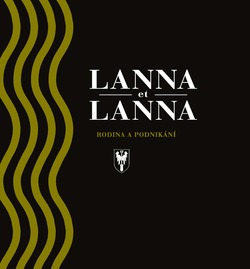LANNA et LANNA. Family and business
 Year of publication:
2022
Year of publication:
2022
 Publisher:
Nebe s. r. o. / Historický ústav
Publisher:
Nebe s. r. o. / Historický ústav
 ISBN:
978-80-906008-1-2; 978-80-7286-399-0
ISBN:
978-80-906008-1-2; 978-80-7286-399-0

The family business and cultural history of the Czech-Austrian business family, the Lannas, lasted a century: from the founding of the family business in 1828, which took over the trade of salt and wood on the River Vltava and built wooden ships in České Budějovice, then the construction of industrial firms in the Kladno region by Adalbert Lanna Sr, followed by the construction of core railway and river transport networks in Bohemia and Upper and Lower Austria by Adalbert Lanna Jr, and until the death of the last male descendant of the family, JUDr. Adalbert Lanna III (1867–1922). This new multidisciplinary study of the entrepreneurial, cultural, societal and patronage activities of these three generations of the Lanna family, as well as an investigation of their habitus, including the symbolism of the decorative motifs on their homes in Prague, Gmunden and their Prague necropolis, result in the first multidimensional perspective on this exceptional family, which lived and did business during three different epochs. The published texts also allow us to peer into the private, public and to some extent the philosophical world of the male members of the Lanna family.
The book contains studies in economic and social history, the history of art, architecture, transport, technology and also in the care for the cultural and technical heritage which the Lannas left behind. The family villas in Palladian style receive special attention, having been built in the 1870s in the exclusive neighbourhoods of Prague suburb Bubeneč and Gmunden, in the Alpine foothills. The Lannas’ Prague villa with its rich paintings by Viktor Barvitius and Heinrich Gärtner, now owned by the Czech Academy of Sciences, hosted the Lanna et Lanna international scientific conference on 1 – 3 July 2021, run by the CAS Institute of History and NEBE. The reports presented at this conference form the basis for this publication.
The texts in the book are accompanied by completely original period photographs and illustrations, many of which were generously provided by descendant of Adalbert Jr along the female line, Hubertus Trauttenberg. The first section looks at the political and economic environment of the Habsburg Monarchy, the beginnings and evolution of transport infrastructure and the specific forms of family businesses which came about in competition and in alliance with the Schwarzenbergs’ aristocratic estates. The Lanna family’s journey from Austria’s Salzkammergut to South Bohemian České Budějovice and then to Prague, and from a social perspective from an artisanal-trading environment to an ennobled big business elite was filled with work of Herculean proportions, the construction of ships, buildings and bridges, operating the horse-drawn railway from České Budejovice to Linz, the engineering of and channelization of rivers, establishment of a steel works and steamship company, the construction of steam railways and long-distance international wood trade, which permanently changed the nature of the Czech and Austrian landscape. All their successfully implemented works of technology and construction mark turning points in the family company’s history. The Lanna family homes tell the story of art lover, collector, patron and founder of cultural and educational institutions in Bohemia, Adalbert Lanna Jr. A journey across the Lanna residences also highlights the character of the youngest and last descendant of the Lanna family, JUDr. Adalbert Lanna, who made the decision to shut down the entirety of the family business, mainly for health and war reasons.
The transformations of the landscape and evolution of cities is focused on in chapters which describe the engineering of the Lower Vltava and Upper Elbe rivers. The pinnacle of the railway entrepreneurship of the Lanna company and its partners, Johannes Schebek and Moritz Gröbe is dealt with by looking at the construction of the Emperor Franz Joseph Railway from Vienna to Budějovice, Plzeň and Cheb, and from Gmünd to Prague.
The book concludes with essays looking at historiography, regional accents, relationships between Czech and German speaking players and also the historical preservation of technical and building heritage on both sides of today’s Czech-Austrian state border. The legacy of the Lanna family and company represents an exceptional cultural and technical heritage in terms of extent and diversity, and one which has lasted into the 21st century.


